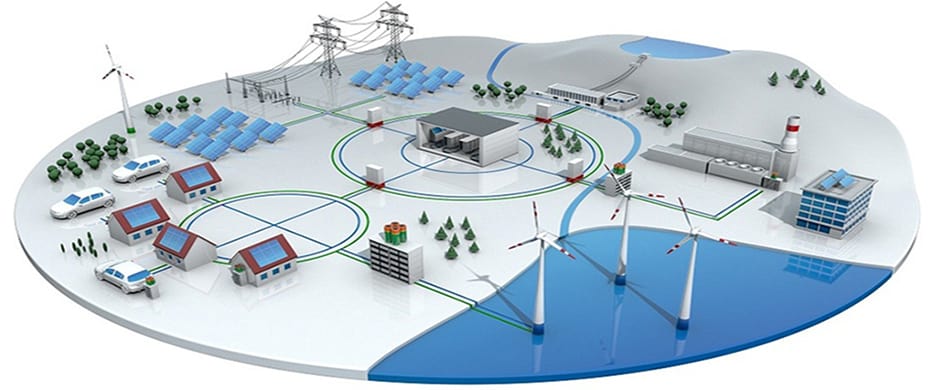Smart Grid & Their Application in the Grid System
What is Grid?
Concept of smart grid is quite in the news and market but majority of the people actually don’t know that what exactly are the things which make a grid smart?
The term “Grid” refer to an “Electric Grid” basically describes a complete network which includes transmission lines, transformers, distribution substation all accessories that are used for delivery of electricity from generation plants to home and commercial scale.

The very first grid was built in decade of 1885-1895 and the with the passage of the time number of grids kept on increasing that’s why by now there are about more than 9200 grids all over the world which are providing about 1 million Megawatt power to the consumers.
As evolution has a direct relation with time so for an efficient functionality of grid, digital technology has been introduced in grid system. This new digital technology enables two way communications which guarantees the direct link between utilities and all consumers.

What is a Smart Grid Then?
In simple words, an automation system between utility and consumers. This smart grid consist of advance digital system, automation, computer and control which make sure to perform a duplex “two way” communication between the power provider and load consumer.
In a typical electrical grid system, electricity provider only will know the power failure when a costumer call them. But in case of smart grid system, if electric supply fails, service provider will automatically respond to the affected area because the components of smart grid provides enough data i.e. from the power transformer, maintransmission and distribution system and finally, to the home supply system (you may say the utility meter).
What Things Make a Grid “Smart”?
According to the Department of Energy (United States), Four types of advance technology will transform a typical electrical grid into Smart Grid which are as follow:
- Fully automated and Integrated two way communication between the overall components of an electric grid.
- Automatic Control for power distribution, faults and repairs.
- Advance management panel, decision support software and mechanism.
- Accurate sensing and measurement technologies.

Upgraded technology of smart grids has well-organized automation equipment and control system, whose response is accurate to meet the rapidly increasing demand for electricity. Time when these smart grids were not implemented all utilities companies were bound to send their respective workers to take meter reading and acquire data related to consumer.

What does a Smart Grid do?
Smart grid performs lots of smart jobs . Some advantages of a smart grid are stated follow:
Efficient Transmission and Distribution of Electric Power.
Quickly restore electric power after power failure due to faults.
Lower cost for operation, maintenance, management and electricity for both utilities and consumers.
Lower electric power tariff and rates due to reduced peak demand.
Provide better options of integration of renewable energy for self power generation systems.
Improve the security and protection.
Quickly restore electric power after power failure due to faults.
Lower cost for operation, maintenance, management and electricity for both utilities and consumers.
Lower electric power tariff and rates due to reduced peak demand.
Provide better options of integration of renewable energy for self power generation systems.
Improve the security and protection.
Applications of a Smart Grid System.
Deployment of Digital Technology in smart grids ensures the reliability, efficiency and accessibility to the consumers regarding all utilities which count towards the economic stability of the nation. Right at the start of transition time it become perilous to execute testing, to improve the technology by up gradation, developing and maintaining standards on a standard threshold and also application of these efficient grids serve all these problems
Basic applications of smart grids are
- They improve the adeptness of transmission lines
- Quick recovery after any sudden breakage/disturbance in lines and feeders
- Cost Reduction
- Reduction of peak demand
- They possess the ability to be integrated with renewable energy sources on a large level which leads to sharing of load and reduction of load on large scale


Gas Insulated Substations
A gas insulated substation (GIS) is a high voltage substation in which the major structures are contained in a sealed environment with sulfur hexafluoride gas as the insulating medium. GIS technology originated in Japan, where there was a substantial need to develop technology to make substations as compact as possible. The clearance required for phase to phase and phase to ground for all equipment is much lower than that required in an air insulated substation; the total space required for a GIS is 10% of that needed for a conventional substation.
Gas insulated substations offer other advantages in addition to the reduced space requirements. Because the substation is enclosed in a building, a GIS is less sensitive to pollution, as well as salt, sand or large amounts of snow. Although the initial cost of building a GIS is higher than building an air insulated substation, the operation and maintenance costs of a GIS are less.
Main Parts of Gas Insulated Sub-Station



No comments:
Post a Comment